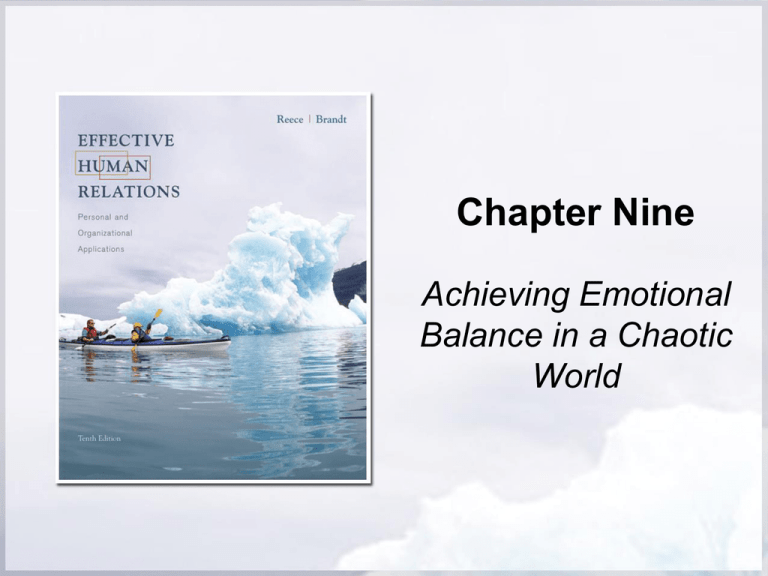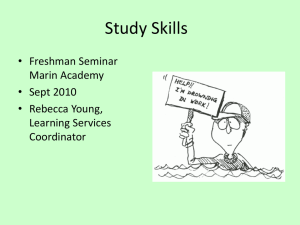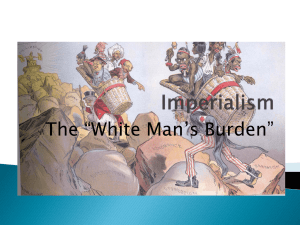
Chapter Nine
Achieving Emotional
Balance in a Chaotic
World
Chapter Preview: Achieving Emotional
Balance in a Chaotic World
• How emotions influence thinking and
behavior
• Factors that contribute to emotional
balance
• Critical role of emotions in the
workplace
• Factors that influence emotional
development
Copyright © Houghton Mifflin Company. All rights reserved.
9|2
Chapter Preview: Achieving Emotional
Balance in a Chaotic World
• Dealing with anger
• Factors that contribute to workplace
violence
• Common emotional styles
• Strategies for achieving emotional
control
Copyright © Houghton Mifflin Company. All rights reserved.
9|3
Emotions: An Introduction
• Emotions are strong, positive or
negative, temporary feelings
• Influence thinking and behavior
• Basic emotions such as jealousy, fear,
love, joy, or grief drive us
• Direct us towards some things and
away from others
• We can gain control over our emotions
Copyright © Houghton Mifflin Company. All rights reserved.
9|4
Figure 9.1 - Behavior Is Influenced
by Activating Events
Copyright © Houghton Mifflin Company. All rights reserved.
9|5
Achieving Emotional Balance—A
Daily Challenge
• Emotional balance has never been more
important
• Choices dictated by our heads (reason/logic)
or hearts (feelings/care)
• Leaders that lack emotional balance breed
fear, confusion, anger and sadness
• Now seeing enormous differences in the
expression of emotions such as aggressive
driving and misbehaving in public events
Copyright © Houghton Mifflin Company. All rights reserved.
9|6
Emotional Intelligence
• IQ is not the only factor that predicts
success
• Emotional intelligence is the ability to
monitor and control one’s emotions and
behavior at work and in social settings
• Emotional intelligence can be learned
Copyright © Houghton Mifflin Company. All rights reserved.
9|7
Personal Competence
• Refers to the competencies that
determine how we manage ourselves
• Competencies in this category include
– Recognizing one's emotions and their
effects
– Keeping disruptive emotions and impulses
in check
– Maintaining standards of honesty and
integrity
Copyright © Houghton Mifflin Company. All rights reserved.
9|8
Social Competence
• Refers to the competencies that
determine how we handle relationships
• Competencies in this category include
– Sensing others' feelings and perspectives
– Listening openly and sending convincing
messages
– Negotiating and resolving disagreements
Copyright © Houghton Mifflin Company. All rights reserved.
9|9
Emotional Expression
• Humans carry a large array of emotions
over a lifetime
• Emotional imbalance can be due to
– Learned inhibition of certain emotions and
overemphasis on the expression of others
– Fixation on a single emotion
Copyright © Houghton Mifflin Company. All rights reserved.
9 | 10
The Emotional Factor at Work
• Emotions play critical role in success of
every organization
• Traditional management training
emphasizes rational, logical process
• Need to do business with meeting of
minds and meeting of hearts
• Compassion key to long-term success
Copyright © Houghton Mifflin Company. All rights reserved.
9 | 11
Total Person Insight
All of our technology is underutilized
and will remain so until we put the
emotion of doing business onto parity
with the logical and rational aspects of
performance improvement.
James C. Georges
Chief Executive Officer, The Par Group
Copyright © Houghton Mifflin Company. All rights reserved.
9 | 12
Relationship Strategy
• Emotional undercurrents are present in
almost every area of every organization
• Relationship strategy--a plan for
establishing, building, and maintaining
quality relationships with customers
• Front-line employees engage in
“emotional labor”
• Emotional labor is often more difficult to
handle than physical labor
Copyright © Houghton Mifflin Company. All rights reserved.
9 | 13
Factors That Influence Our Emotions
• Achieving greater emotional control
starts with
– Determining source of emotional difficulties
– Studying factors that influence emotional
development
• Temperament
• Unconscious influences
• Cultural conditioning
Copyright © Houghton Mifflin Company. All rights reserved.
9 | 14
Temperament
• Refers to a person’s individual style of
expressing needs and emotions
• Both biologically and genetically based
• Personality at any age reflects an
interaction between temperament and
the environment
Copyright © Houghton Mifflin Company. All rights reserved.
9 | 15
Total Person Insight
An emotion has at least three necessary
components: the felt bodily experience,
the cognition or thought, and the
expressive reaction.
Daniel Brown
Clinical Professor, Harvard Medical School
Copyright © Houghton Mifflin Company. All rights reserved.
9 | 16
Unconscious Influences
• The unconscious mind is a vast
storehouse of forgotten memories,
desires, ideas, and frustrations
• Can have a powerful influence on
behavior
• Unconsciousness influences conscious
decision-making
• Childhood experience can cause
emotions out of proportion to a current
situation
Copyright © Houghton Mifflin Company. All rights reserved.
9 | 17
Transactional Analysis (TA)
• Unconscious childhood memories can
bring out emotions
• The brain acts like a two-track stereo
tape recorder that records
– events
– feelings associated with events
• Incorporated into many corporate
training programs
Copyright © Houghton Mifflin Company. All rights reserved.
9 | 18
Cultural Conditioning
• Culture is what we see and hear so
often that we call it reality
• Shapes nearly every aspect of behavior
and mental processes
• Most countries are multicultural
• Cultural influences have a dramatic
effect on American adults and children
Copyright © Houghton Mifflin Company. All rights reserved.
9 | 19
Important Roles of Emotions
• It is important to remain open to the full
range of emotions that influence our
thinking and behavior
• Emotional undercurrents are present in
every aspect of our work
• Separating our mental and emotional
energies at work is very difficult
because they are so intertwined
Copyright © Houghton Mifflin Company. All rights reserved.
9 | 20
Coping with Your Anger and
the Anger of Others
• Anger is defined as the thoughts,
feelings, physical reactions, and actions
that result from the unacceptable
behavior of others
• Anger is a response to perceived
injustice, which may dissolve with better
understanding
• Anger in the workplace is on the rise
Copyright © Houghton Mifflin Company. All rights reserved.
9 | 21
Managing Your Anger
• Learning to deal with anger and the
anger of others is a sophisticated and
mature skill people should learn
• Monitor your anger
– How often do you get angry each day?
– What are the causes of irritation in your
life?
– How upsetting is each episode of anger?
– How well do you manage each episode?
Copyright © Houghton Mifflin Company. All rights reserved.
9 | 22
Managing Your Anger
• Use a diary or journal to determine the
impact of anger in your life
– Record source of irritation and the feelings
that surface
– Record the behaviors you display when
angry
• People who monitor their behavior
carefully, see positive results
Copyright © Houghton Mifflin Company. All rights reserved.
9 | 23
Effective Ways to Express Your Anger
• Buddha says “You will not be punished
for your anger, you will be punished by
your anger.”
• Expressing anger can be therapeutic
• Many people are unsure about the best
way to self-disclose this emotion
• Appropriate expression improves the
chances of accurate reception and
response
Copyright © Houghton Mifflin Company. All rights reserved.
9 | 24
Effective Ways to Express Your Anger
• Avoid reacting in a manner that could be
seen as emotionally unstable
• Do not make accusations or attempt to
fix blame
• Express your feelings in a timely manner
• Be specific as you describe the factors
that triggered your anger, and be clear
about the resolution you are seeking
Copyright © Houghton Mifflin Company. All rights reserved.
9 | 25
Total Person Insight
We can suppress anger or act it
out, either way making things
worse for ourselves and others. Or
we can practice patience: wait,
experience the anger and
investigate its nature.
Pema Chodron
Author and Buddhist Teacher
Copyright © Houghton Mifflin Company. All rights reserved.
9 | 26
How to Handle Other People’s Anger
• Dealing with other people’s anger is the
most difficult human relations challenge
• Recognize and accept the other
person’s anger
• Encourage the angry person to vent
feelings
• Do not respond to an angry person with
anger
• Give the angry person feedback
Copyright © Houghton Mifflin Company. All rights reserved.
9 | 27
Violence in the Workplace
• Ranked as the number one concern by
security officials
• Reduces productivity
• Potential triggers
– Loss of job
– Conflict between employee and
management
– Personal tragedy
– Abusive behavior by supervisors
– Rigid, impersonal work environment
Copyright © Houghton Mifflin Company. All rights reserved.
9 | 28
Violence in the Workplace
• Workplace violence encompasses a
wide range of behaviors including
– Hostile remarks
– Intimidation through stalking
– Physical assaults
– Threatening phone calls
– Homicide
Copyright © Houghton Mifflin Company. All rights reserved.
9 | 29
Employee Sabotage
• Employee misconduct combined with an
edge of revenge
• Employee sabotage may involve:
– Deliberate nonperformance -Arson
– Financial fraud
-Computer Crimes
– Destruction of equipment
-Slander
• Many employees act out anger rather
than discuss it
Copyright © Houghton Mifflin Company. All rights reserved.
9 | 30
Preventing Workplace Violence
• Use hiring procedures that screen out
unsuitable persons
• Develop a strategy for dealing with
incidents before they actually occur
• If someone must be fired or laid off, do
so in a way that does not demoralize
the employee
Copyright © Houghton Mifflin Company. All rights reserved.
9 | 31
Preventing Workplace Violence
• Provide out-placement services for laidoff or terminated employees
• Establish a systematic way to deal with
disgruntled employees
• Provide supervisors and managers with
training that will help them prevent
workplace violence and deal effectively
with it
Copyright © Houghton Mifflin Company. All rights reserved.
9 | 32
Emotional Styles
• Your emotional style started taking
shape before you were born and
evolved over a period of many years
• You are likely to display one of four
different emotional styles
– Suppressing
– Capitulating
– Overexpressing
– Accommodating
Copyright © Houghton Mifflin Company. All rights reserved.
9 | 33
Suppressing Your Emotions
• People learn to suppress their feelings
• Some develop intellectual strategies to
avoid dealing directly with emotional
reactions
• Mental and physical health problems
can develop
Copyright © Houghton Mifflin Company. All rights reserved.
9 | 34
Figure 9.2 - The Sedona Method
Copyright © Houghton Mifflin Company. All rights reserved.
9 | 35
Capitulating to Your Emotions
• People see themselves as helpless
victims of feelings that they cannot
control
• Responsibility for a problem assigned to
external causes while the person suffers
in silence
• Often overly concerned about attitudes
and opinions of others
Copyright © Houghton Mifflin Company. All rights reserved.
9 | 36
Overexpressing Your Emotions
• Frequently displays lack of emotional
control
• Quick way to damage one’s image at
work
• Write down rather than express
emotions
• Releases toxic feelings
• Prepare to deal constructively with
situation
Copyright © Houghton Mifflin Company. All rights reserved.
9 | 37
Accommodating Your Emotions
• Accommodation means that a person is
willing to
– recognize, accept, and experience
emotions
– attempt to react in ways appropriate to the
situation
• Integrates one’s feelings and the
thinking process
• “Think before you act” point of view
Copyright © Houghton Mifflin Company. All rights reserved.
9 | 38
Gender Differences in Emotional Style
• Women see men as too rational and
insensitive
• Men see women as too emotional
• Differences can be attributed to
– Early learning
– Conditioning
– Expectations of family
• Important for each person to respect the
other person’s style
Copyright © Houghton Mifflin Company. All rights reserved.
9 | 39
Strategies for Achieving
Emotional Control
• We have a certain amount of mental,
emotional and physical energy each day
• We can learn to discipline the mind to
banish thoughts that waste energy
Copyright © Houghton Mifflin Company. All rights reserved.
9 | 40
Identifying Your Emotional Patterns
• Taking time to study emotional patterns
helps predict or anticipate an emotional
response
– Record them in a journal
– Set aside quiet time to reflect on your
emotional patterns
– Make a chart of your emotions throughout
the day
– Repeat process over several days
Copyright © Houghton Mifflin Company. All rights reserved.
9 | 41
Fine-Tuning Your Emotional Style
• After identifying emotional patterns you
want to change, consider ways to finetune your emotional style
• Disciplining your mind can help you live
a fuller, satisfying life
Copyright © Houghton Mifflin Company. All rights reserved.
9 | 42
Fine-Tuning Your Emotional Style
• Take responsibility for your emotions
• Put your problems into proper
perspective
• Take steps to move beyond negative
emotions such as envy, anger, jealousy
and hatred
• Give your feelings some exercise
Copyright © Houghton Mifflin Company. All rights reserved.
9 | 43
Total Person Insight
It’s unfortunate that we’re never really taught
how to show emotion in ways that help our
relationships. Instead, we’re usually told what
we should not do. However, too little emotion
can make our lives seem empty and boring,
while too much emotion, poorly expressed,
fills our interpersonal lives with conflict and
grief. Within reason, some kind of balance in
the expression of emotion seems to be called
for.
Gerard Egan
Author, You and Me
Copyright © Houghton Mifflin Company. All rights reserved.
9 | 44
Chapter Review
• How emotions influence thinking and
behavior
– We carry emotions that help us cope with
our environment
– Emotions are feelings that influence our
thinking and behavior
Copyright © Houghton Mifflin Company. All rights reserved.
9 | 45
Chapter Review
• Factors that contribute to emotional
balance
– We need to discover ways to achieve
emotional balance
– We sometimes lack emotional balance
because we suppress some emotions and
over express others
– Emotional intelligence helps achieve
emotional balance
Copyright © Houghton Mifflin Company. All rights reserved.
9 | 46
Chapter Review
• Critical role of emotions in the
workplace
– Emotions are critical to success of every
organization
– Emotional undercurrents are present in
organizations
– Emotional undercurrents influence
employee morale, customer loyalty, and
productivity
Copyright © Houghton Mifflin Company. All rights reserved.
9 | 47
Chapter Review
• Factors that influence emotional
development
– Emotional development is influenced by
temperament, our unconscious mind, and
cultural conditioning
– They influence our emotional intelligence
Copyright © Houghton Mifflin Company. All rights reserved.
9 | 48
Chapter Review
• Dealing with anger
– Appropriate expressions of anger
• Improve interpersonal relationships
• Reduce anxiety
• Provide an outlet for unhealthy stress
– We must also learn how to handle other
people’s anger
– Dealing with anger, ours and other’s, takes
effort
Copyright © Houghton Mifflin Company. All rights reserved.
9 | 49
Chapter Review
• Factors that contribute to workplace
violence
– Workplace violence encompasses
• Homicides
• Physical assaults
• Hostile remarks
• Sabotage
– Violence cannot be eliminated, but steps
can be taken to curb violent employee
behavior in the workplace
Copyright © Houghton Mifflin Company. All rights reserved.
9 | 50
Chapter Review
• Common emotional styles
– To achieve emotional balance start with an
examination of your current style
• Suppressing emotions
• Capitulating to them
• Over expressing them
• Accommodating them
– Researchers suggest that there are gender
differences in emotional style
Copyright © Houghton Mifflin Company. All rights reserved.
9 | 51
Chapter Review
• Strategies for achieving emotional
control
– Emotional control is an important
dimension of emotion style
– Identify your current emotional patterns
• Record your anger experiences in a
journal
• Set aside time for quiet reflection
• Develop a chart of your emotional
landscape
Copyright © Houghton Mifflin Company. All rights reserved.
9 | 52







